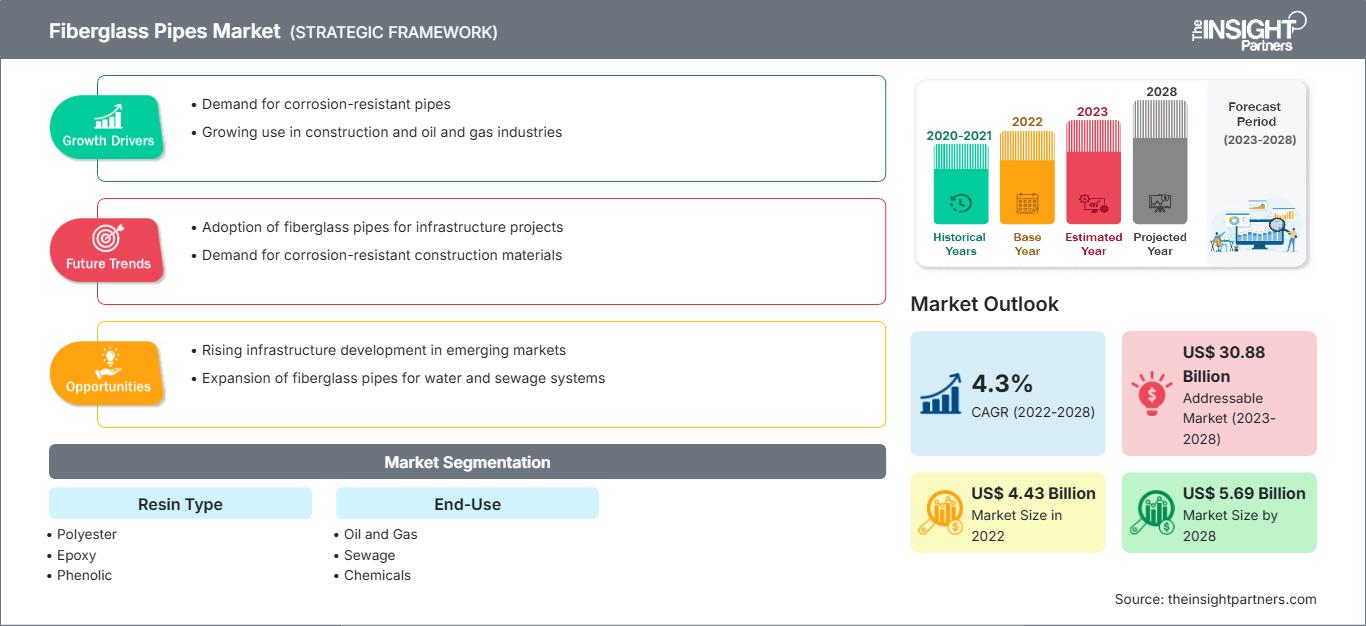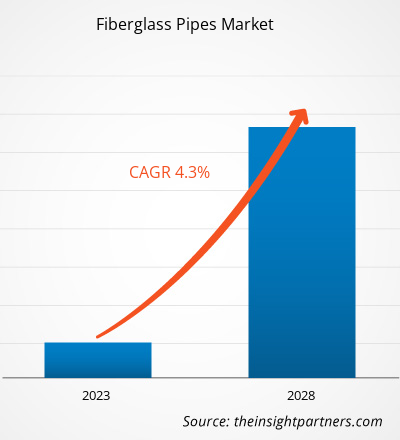[Research Report] The fiberglass pipes market was valued at US$ 4,431.10 million in 2022 to US$ 5,692.52 million by 2028; it is expected to grow at a CAGR of 4.3% from 2022 to 2028.
MARKET ANALYSIS
Fiberglass pipes are manufactured by contact molding or filament winding process, using glass fiber reinforcement and resin systems such as polyester, epoxy, and phenolic resin. Fiberglass pipes have been commonly used to transport petroleum products and natural gas. Fiberglass pipes are composite pipes with excellent resistance against corrosive environments, including soils, hydrocarbons, salt water, H2S, and chemical compounds, which can be encountered in any oil field. Fiberglass pipes are extremely durable, have a small friction coefficient, and exhibit less wear, due to which it is highly preferred in oil and gas applications. Fiberglass pipe is an excellent and cost-efficient choice for water supply and wastewater applications, with long-term maintenance and low pump operating costs due to corrosion-related friction loss.
GROWTH DRIVERS AND CHALLENGES
The increasing installation of oil & gas pipelines across the globe has aided the market growth of fiberglass pipes. Fiberglass pipes are considered a reliable and cost-effective alternative to steel pipes for onshore and offshore corrosion control in the low to high-pressure oil & gas sector. The oil & gas industry is reporting increasing fuel demand due to rapid economic growth and rising oil utilization for applications such as feedstock and power generation. In 2021, Russia was among the top five largest energy producers and consumers in the world, producing 595.2 million tons of crude oil, of which 286.6 million tons were exported, according to the report published by Bruegel AISBL in 2023. The report also revealed that crude oil is exported by two main routes—pipeline and oil tanker at sea. According to the report released by Center for Eastern Studies in 2023, the government of Russia planned to boost the gas exports to China accounting for shipment of 98 billion cubic meters of gas per year, partially achieved through a planned Power of Siberia-2 pipeline, by 2030. Moreover, the rising demand for fiberglass pipes from chemical industry is another factor aiding the growth of fiberglass pipes. The fluctuation in prices of raw materials poses a challenge to the fiberglass pipes market. Fiberglass is extensively used in several industries such as energy, electronics, automotive, transportation, construction materials, and infrastructure building materials, due to its high strength, lightweight, and design flexibility. The cost of raw materials, fuel, and labor increased significantly in 2021, which raised the fiberglass production costs.
Customize This Report To Suit Your Requirement
You will get customization on any report - free of charge - including parts of this report, or country-level analysis, Excel Data pack, as well as avail great offers and discounts for start-ups & universities
Fiberglass Pipes Market: Strategic Insights

-
Get Top Key Market Trends of this report.This FREE sample will include data analysis, ranging from market trends to estimates and forecasts.
REPORT SEGMENTATION AND SCOPE
The "Global Fiberglass pipes Market Analysis to 2030" is a specialized and in-depth study with a major focus on the global market trends and growth opportunities. The report aims to provide an overview of the global market with detailed market segmentation by resin type, end-use, and geography. The global fiberglass pipes market has been witnessing high growth over the recent past and is expected to continue this trend during the forecast period. The report provides key statistics on the consumption of fiberglass pipes worldwide along with their demand in major regions and countries. In addition, the report provides the qualitative assessment of various factors affecting the fiberglass pipes market performance in major regions and countries. The report also includes a comprehensive analysis of the leading players in the fiberglass pipes market and their key strategic developments. Several analyses on the market dynamics are also included to help identify the key driving factors, market trends, and lucrative opportunities that would, in turn, aid in identifying the major revenue pockets.
Further, ecosystem analysis and Porter’s five forces analysis provide a 360-degree view of the global fiberglass pipes market, which helps understand the entire supply chain and various factors affecting the market growth.
SEGMENTAL ANALYSIS
The global fiberglass pipes market is segmented on the basis of resin type, and end-use. Based on resin type, the fiberglass pipes market is segmented as, polyester, epoxy, phenolic, and others. On the basis of end-use, the market is classified as, oil and gas, sewage, chemicals, agriculture, and others. Based on resin type, the polyester segment accounted for a significant share. Polyester resin is a polymer that is simple to use and economical and is a major component in many industries. It is the most frequently used pultrusion resin in the composite manufacturing sector, as these are highly adjustable when it comes to the construction of polymer chains. Epoxy resins are used by manufacturers to produce Glass Reinforced Epoxy (GRE) pipes, utilized in the marine and offshore, oil & gas and petrochemical markets. Phenolic resin is used to manufacture fiberglass pipes for the oil & gas industry because of its high resistance properties. The others segment of resin type includes vinyl ester resins and polyurethane resins. Based on end-use, oil & gas segment accounted for a major share owing to a consistent rise in oil and gas exploration and production. Fiberglass pipes are highly recommended in sewage treatment due to their superior strength-to-weight ratio and resistance to corrosion. Fiberglass pipes are consumed in chemical plants to transport chemical liquids and industrial gases.
REGIONAL ANALYSIS
The report provides a detailed overview of the global fiberglass pipes market with respect to five major regions, namely; North America, Europe, Asia-Pacific (APAC), Middle East and Africa (MEA) and South & Central America. Asia Pacific accounted for a significant share of the market and valued at more than US$ 1,000.00 million in 2022 and estimated to reach approximately US$ 2,000.00 million in 2028. Asia Pacific region is a prominent market for fiberglass pipes owing to growth in the chemical and oil & gas sectors and a rise in urbanization, leading to increased demand for sewage systems. According to the International Council of Chemical Associations (ICCA), the Asia Pacific chemical industry is the largest contributor to the region’s GDP and employment, generating 45% of the industry's total annual economic value and 69% of all jobs supported. The rise in foreign direct investments also leads to regional economic growth, further bolstering industrialization in the region. Europe is also expected to witness considerable growth valued at approximately US$ 950.00 million in 2022, attributed to the increasing utilization of fiberglass pipes from various industries, including oil & gas, chemicals, and water & wastewater treatment.
INDUSTRY DEVELOPMENTS AND FUTURE OPPORTUNITIES
The report provides a detailed overview of the global fiberglass pipes market with respect to five major regions, namely; North America, Europe, Asia-Pacific (APAC), Middle East and Africa (MEA) and South & Central America.
In March, 2023, Future Pipe Industries (Egypt) received a Certificate of Appreciation from the company’s strategic business partner Petrobel Petroleum Co, for installation of GRE crude oil transition line from tanks to Petrico (Egypt).
In February, 2022, Future Pipe Industries expanded its manufacturing facility in Saudi Arabia by adding two new production lines of FlexstrongTM, a high-pressure spoolable pipe, with diameter up to 6 inches.
IMPACT OF COVID/IMPACT OF GEOPOLITICAL SCENARIO/IMPACT OF RECESSION
The report provides a detailed overview of the global fiberglass pipes market with respect to five major regions, namely; North America, Europe, Asia-Pacific (APAC), Middle East and Africa (MEA) and South & Central America. The COVID-19 pandemic adversely impacted the global economy and slowed the growth of various industries such as oil & gas, chemicals & materials, and agriculture. The shutdown of multiple manufacturing plants and factories in North America, Europe, Asia Pacific, South America, and the Middle East & Africa disrupted the global supply chain. Many companies announced possible delays in product deliveries and projected a slump in their product sales. In addition, travel restrictions imposed by countries in Europe, Asia Pacific, and North America hindered business collaborations and partnership opportunities. All these factors hampered the progress of the chemicals & materials industry and restrained the growth of various markets related to this industry. In 2021, businesses regained their production capacities as the governments of various countries eased out the previously imposed restrictions. Moreover, an increase in COVID-19 vaccination drives eased the situation leading to a rise in business activities across the world. The start of operations in the manufacturing units positively impacted the fiberglass pipes market. Further, manufacturers could overcome the demand and supply gap by operating at total capacity. Moreover, the export and import volumes in the chemicals & materials industry are projected to increase significantly in the coming years due to the relaxation of border and trade restrictions.
Fiberglass Pipes Market Regional InsightsThe regional trends and factors influencing the Fiberglass Pipes Market throughout the forecast period have been thoroughly explained by the analysts at The Insight Partners. This section also discusses Fiberglass Pipes Market segments and geography across North America, Europe, Asia Pacific, Middle East and Africa, and South and Central America.
Fiberglass Pipes Market Report Scope
| Report Attribute | Details |
|---|---|
| Market size in 2022 | US$ 4.43 Billion |
| Market Size by 2028 | US$ 5.69 Billion |
| Global CAGR (2022 - 2028) | 4.3% |
| Historical Data | 2020-2021 |
| Forecast period | 2023-2028 |
| Segments Covered |
By Resin Type
|
| Regions and Countries Covered |
North America
|
| Market leaders and key company profiles |
|
Fiberglass Pipes Market Players Density: Understanding Its Impact on Business Dynamics
The Fiberglass Pipes Market is growing rapidly, driven by increasing end-user demand due to factors such as evolving consumer preferences, technological advancements, and greater awareness of the product's benefits. As demand rises, businesses are expanding their offerings, innovating to meet consumer needs, and capitalizing on emerging trends, which further fuels market growth.

- Get the Fiberglass Pipes Market top key players overview
COMPETITIVE LANDSCAPE AND KEY COMPANIES
Some of the key players operating in the fiberglass pipes market include, Amiblu Holding GmbH, Chemical Process Piping Pvt Ltd, EPP Composites Pvt Ltd, Fibrex LLC, Future Pipe Industries LLC, Gruppo Sarplast Srl, Kuzeyboru AS, Lianyungang Zhongfu Lianzhong Composites Group Co Ltd, NOV Inc, Saudi Arabian Amiantit Co, Sunrise Industries (India) Ltd, Poly Plast Chemi Plants (I) Pvt Ltd, Plasticon Germany GmbH, and Kurotec-KTS GmbH, among others.
Frequently Asked Questions
What are the opportunities for fiberglass pipes in the global market?
What are the key drivers for the growth of the global fiberglass pipes market?
What is the largest region of the global fiberglass pipes market?
Based on resin type, why does the polyester fiberglass pipes segment have the largest revenue share?
Based on end use, which is the fastest-growing segment in the fiberglass pipes market?
Can you list some of the major players operating in the global fiberglass pipes market?
- Historical Analysis (2 Years), Base Year, Forecast (7 Years) with CAGR
- PEST and SWOT Analysis
- Market Size Value / Volume - Global, Regional, Country
- Industry and Competitive Landscape
- Excel Dataset
Recent Reports
Related Reports
Testimonials
Reason to Buy
- Informed Decision-Making
- Understanding Market Dynamics
- Competitive Analysis
- Identifying Emerging Markets
- Customer Insights
- Market Forecasts
- Risk Mitigation
- Boosting Operational Efficiency
- Strategic Planning
- Investment Justification
- Tracking Industry Innovations
- Aligning with Regulatory Trends





















 Get Free Sample For
Get Free Sample For